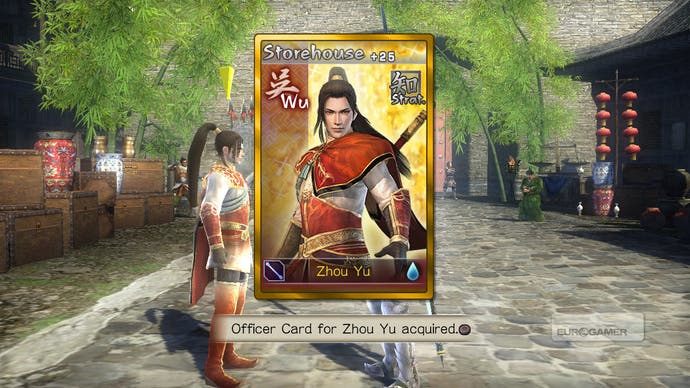Dynasty Warriors: Strikeforce
Don't be Koei.
During missions you earn experience, material resources and money that can be spent in the game's various retail outlets. At the academy you spend experience points acquiring Chi powers. Your character can equip up to four Chi skills at once, one attached to each limb, represented as a phosphorus bangle. These range in effect and usefulness from, for example, reducing the speed it takes your character to stand up after being knocked down, to increasing healing items' potency, increasing the speed of your all-important dash or adding an elemental property to your damage.
Likewise, at the workshop you can spend points and resources increasing your character's base ability, attack power, movement and even the frequency and range of enemy drops. Visiting the blacksmith allows you to focus on the weaponry your character carries, either forging new weapons from a dizzying array of types, or adding augmentations to these weapons in their buff slots. Buffs can increase the length of potential combos or grant bonuses to your character such as the speed of their movement on the battlefield, or defence stats and add a secondary tier of strategy to what is already a flexible and rich system.
Weapons and augmentations are purchased with a combination of money and materials earned after each battle, and it's not long before you've acquired enough raw materials to be able to specialise in almost any weapon type available in the game. Moreover, if you're missing any item in particular, you can visit the Market to exchange common items for more rare loot. These imports from Capcom's Monster Hunter suit the Dynasty Warriors universe well, and the fast and tangible improvements to your character's performance on the battlefield makes the potential for tinkering in menus seem worthwhile and responsive.

Side missions are delivered from a notice board in town, while the town's gatekeeper presents those crucial to the story. In both cases, you'll earn bonus experience and loot if you manage to meet specified bonus criteria in battle, by finishing off the enemy's presiding officer within a time limit, or by taking down a set number of enemies. Missions can all be repeated either for loot or to grind, with new battles and chapters opening up as you clear key missions in the story's timeline.
As with all Dynasty Warriors titles, there is a generous amount of content on offer here, with five story chapters for each of the three kingdoms and a raft of characters, outfits and treasures unlockable in each. Strikeforce's other key new component is co-operative play, with the option to fight with up to three other players online. As with Monster Hunter, the emphasis here is as much on showboating to your teammates about the weaponry you've crafted and moves you've customized as it is about clearing stages. The robust netcode and seamless switching between online and offline modes of play in the hub city makes for an agreeable extension to the Dynasty Warriors format.

That's a phrase that could be used to define the whole of Strikeforce; it extends the series in intelligent and welcome ways. While it's in no way the radical rethinking of the genre that Bladestorm was, it pushes the Dynasty Warriors boundaries further than they've moved in years. A package of mixed success then, one that answers its longtime critics on a number of significant levels, but which fails to deliver the sort of polish and presentation required to find a truly global audience.
